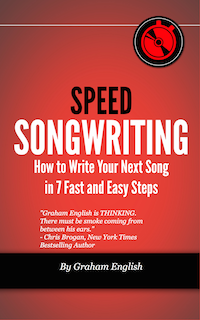
If you’re not surprising your listeners—or yourself—your songs might be predictable, forgettable, or, let’s be honest, boring.
The element of surprise is the secret sauce that keeps listeners engaged, turning moments of expectation into moments of delight. Surprise is what makes a song stand out and what keeps it replaying in someone’s head.
Want to infuse your music with unpredictability? You don’t need to overhaul your process. You just need to tweak five key areas: melody, chords, lyrics, song sections, and rhythm.
Let’s break it down step by step so you can start adding surprises today.
1. Unexpected Melody Notes
Melody is where you can play with expectations. Lead the listener somewhere familiar—and then take a left turn.
Start with a simple melody, something singable. Play or sing a phrase, and then resist the temptation to resolve it where they’d expect. For example, in the key of C, the tonic note (C) feels like home. Instead of landing there, take the melody higher to a D or drop it suddenly to a Bb. It creates a sense of tension, leaving the listener hanging.
You can also surprise with leaps. Instead of moving smoothly from note to note, jump a fifth or an octave. The shift jolts the listener in a way that feels fresh and exciting.
Here’s how to experiment:
- Sing a melody as if it were a question, and avoid “answering” it too soon.
- Establish a pattern, like descending notes, and then abruptly reverse it.
Surprises like these make melodies stick in your listener’s mind, creating intrigue they won’t forget.
2. Unexpected Chords
Your chord choices can completely transform the emotional direction of a song. Instead of sticking to the obvious progressions, throw in a wild card.
Start with a standard I-IV-V progression. In the key of C, that’s C, F, and G. Now, subvert expectations. Try a Bb chord (borrowed from the parallel minor) between F and G. Or use a deceptive cadence: instead of resolving from G7 to C, resolve to Am. These small twists feel unexpected but still harmonious.
Prince’s “Sometimes It Snows in April” is a masterclass in harmonic sophistication. The chorus surprises with a B♭ chord (B♭sus2) in the middle of an E major progression. This chromatic insertion between the Aadd9 and Bsus2 chords creates a moment that feels both striking and seamless.
The next time you’re writing, play through your chord progression and ask yourself: “What if I went somewhere completely different here?” Then try it. Even one unexpected chord can make your song unforgettable.
3. Unexpected Lyrics
Lyrics thrive on surprise. A well-placed twist can captivate listeners and leave a lasting impression.
One way to achieve this is by flipping the emotional tone. Start with a familiar or uplifting theme, then introduce an unexpected shift in the final line. For instance, concluding a hopeful stanza with a line that reveals doubt or loss can create a powerful impact.
For example:
I wandered through the morning mist,
The world awash in golden bliss.
Birds sang tales of joy and grace,
But silence fell upon this place.
Alternatively, you can break the rhyme scheme to draw attention:
We sailed across the endless sea,
With dreams as vast as dreams can be.
The stars aligned to light our way,
And then the compass failed.
Here, the rhyme scheme starts as AABB ("sea" rhymes with "be," "way" would typically be followed by a perfect rhyme with "way"), but the last line contains an imperfect rhyme, breaking the expected pattern. This disruption emphasizes the unexpected event, drawing the listener's attention.
Unexpected imagery can also enhance your lyrics. Replace clichés with vivid, surprising details. Instead of saying, "eyes like stars," you might write, "eyes hide storms."
Here’s what to do next: Rewrite one verse or chorus of your song, flipping its emotional tone or breaking its rhyme scheme. Aim for the last line to land like a plot twist, leaving your listeners eager for more.
4. Unexpected Song Sections
Your song’s structure is where you can catch the listener off guard. Most songs follow a predictable verse-chorus-bridge format. What if yours didn’t?
Start with the chorus instead of a verse. Think of “We Will Rock You” by Queen—straight into the chant, no buildup. Or end your song abruptly, cutting it off mid-phrase. This creates a jarring, memorable effect.
You can also insert a “false ending.” Let the music fade out, then slam back in with a new section or reprise of the chorus. It’s the musical equivalent of a plot twist in a movie.
Try this:
- Take one of your existing songs and flip its sections. Move the chorus to the beginning.
- Experiment with cutting out an entire section. Does the song still work? Does it feel tighter?
Tweaking your structure is like playing Tetris with emotions—keep the listener on their toes.
5. Unexpected Rhythms
Rhythm is the unsung hero of surprise. Even small shifts can disrupt expectations in a powerful way.
Take a standard 4/4 beat and throw in a 2/4 measure. It’s a subtle but effective trick that catches listeners off guard. Or go bigger: Add a 5/4 or 3/4 bar in the middle of a 4/4 song. The unexpected change forces the listener to re-engage with the beat.
One fun way to experiment is with phrasing. Extend or shorten a vocal phrase so it doesn’t land where the listener expects. You could delay the start of a line, let a chord hang, or cut off a note early.
Want a fun example? Harry Connick Jr. once flipped an audience’s clap rhythm by adding an extra beat, moving the emphasis to the correct time signature. It’s a playful reminder of how powerful rhythm can be.
Here’s a challenge: In your next song, add one unexpected rhythmic shift. It could be a pause, an extra beat, or a sudden tempo change. Notice how it forces the listener to pay attention.
Creating a Habit of Surprise
Surprise doesn’t have to be accidental. You can build it into your process. Start by experimenting with these five areas—one at a time. Don’t try to do everything in a single song.
First, schedule a 15-minute songwriting session every day. Focus on just one element, like melody. Ask yourself: “What’s the most obvious thing I could do here—and how can I avoid it?”
Keep a journal of your ideas. Track what works and what doesn’t. Over time, you’ll start to notice patterns in how you create surprises. And you’ll get better at it.
The key is to make experimentation a habit. Even if you’re working on a tight deadline or feel stuck, these techniques will help you break through.
Wrapping Up
Great songs are a mix of the predictable and the unexpected. They comfort us with familiarity while thrilling us with surprises.
By playing with melody, chords, lyrics, structure, and rhythm, you can inject your music with the kind of twists and turns that keep listeners hooked. And the best part? These techniques aren’t just for your audience—they’ll make songwriting more exciting for you, too.
So, start today. Open up your latest song, and ask yourself: “Where can I surprise someone here?” Then do it. Because in music, just like in life, the best moments are the ones you don’t see coming.

Enter your first name and email address below and click “GET ACCESS NOW!” to get the Speed Songwriting Cheat Sheet delivered to your inbox!
We guarantee 100% privacy. Your information will not be shared.

I’m not a working musician, but my hope is to learn how to write a few good songs. Although time is very valuable and so many things pressing it’s hard to find the time to focus on one thing. However a little bit each day may flourish.
You’re absolutely right—consistency is key. Even just 10-15 minutes a day can add up over time and lead to real progress. Start small, stay consistent, and you’ll be amazed at how those little daily efforts can flourish into great songs. Keep at it!